Impact of Blockchain Technology on Smart Grids
Abstract
1. Introduction
2. Background and Motivation
| Author & Year | Area of Focus | Intermittency and Uncertainty | Grid Balancing | Issues Identified Power Quality | Coordination | Integration of EVs |
|---|---|---|---|---|---|---|
| S. K. Rathor and D. Saxena, 2020 [17] | Energy Management systems |
| X |
|
|
|
| J. A. P. Lopes et al., 2019 [1] | Smart Grids |
|
|
|
|
|
| L. Lind, R. Cossent, J. P. Chaves-Ávila, and T. Gómez San Román, 2019 [2] | Transmission and Distribution systems |
|
|
|
| X |
| E. M. Carlini, R. Schroeder, J. M. Birkebaek, and F. Massaro, 2019 [21] | Impacts of Renewable energy resources |
|
|
|
| X |
| A. K. Singh and S.K. Parida, 2017 [5] | Deregulated Electricity Market |
| X |
| X | X |
3. Methodology
3.1. Review Questions
- (1)
- What are the main areas where blockchain technology is being used in smart grids?
- (2)
- What research methodologies have been used to blockchain-enabled smart grids?
- (3)
- What challenges do smart grids have while using blockchain technology?
- (4)
- What are the research gaps that need to be filled before blockchain technology can be used in smart grids practically?
- (5)
- What may the future of blockchain technology research in the smart grids look like?
3.1.1. Search Methods
- -
- Scopus;
- -
- Web of Science.
| TITLE-ABS-KEY ((“distributed energy resourc*” OR “DER” OR “smart grid” OR “distributed generation*” OR “renewable energy sourc*”) AND (“smart contrac*” OR blockchain OR “distributed Ledge*”)) |
3.1.2. Screening Method
3.2. Review of Methodologies Used
| Comparison of Commonly Used Blockchain Technologies and Consensus Algorithms | ||||
| Entity | Name | Research Articles | Strengths | Weaknesses |
| Blockchain Technology | Ethereum | MengelKamp et al. (2018) [8] Vavalis and Foti (2019) [40] Afzal et al. (2020) [41] |
|
|
| Bitcoin | Armani et al. (2019) [42] |
|
| |
| Hyperledger Fabric | Goranovicet al. (2019) [43] Patsonakis et al. (2019) [44] |
|
| |
| Consensus Mechanism | Proof of Work (PoW) | Hua and Sun (2010) [33] Jindal et al. (2019) [45] |
|
|
| Proof of Authority (PoA) | Nurgaliev et al. (2019) [36] Ahl et al. (2019) [46] |
|
| |
| Proof of Stake (PoS) | Fan and Zhang (2019) [47] Niu and Zhang (2019) [34] |
|
| |
| Practical Byzantine Fault Tolerance (pBFT) | Sheikh et al. (2020) [35] Su et al. (2019) [48] |
|
| |
4. State of the Art
4.1. Current Areas of Research
- (1)
- Transactive energy—which includes local markets, P2P trading, and smart contract methodologies;
- (2)
- Electric Vehicle Integration—which includes EV charging mechanisms and Vehicle to Grid trading;
- (3)
- Privacy and Security—works focused on ensuring privacy and security of blockchain-based smart grids and trading mechanisms;
- (4)
- Demand Response—blockchain-based smart contracts and mechanisms made for adjusting electricity demand to match the supply.
4.2. Challenges
4.3. Transactive Energy
“Techniques for managing the generation, consumption, or flow of electric power within an electric power system through the use of economic or market-based constructs while considering grid reliability constraints.”
4.4. Electric Vehicle Integration
4.5. Privacy and Security
4.6. Demand Response
“Changes in electric usage by end-use customers from their normal consumption patterns in response to changes in the price of electricity over time, or to incentive payments designed to induce lower electricity use at times of high wholesale market prices or when system reliability is jeopardized.” [102]
4.7. Miscellaneous Areas of Application
5. Research Gaps and Suggested Future Directions
5.1. Research Gap 1: Incorporating Demand and Supply Forecasts in Energy Markets to Understand the Impact of Uncertainty on Market Mechanisms
5.2. Research Gap 2: The Creation of Autonomous Pricing Systems and Trading Schemes for Energy-Enabling Individual Prosumers to Take a Passive Role in the Energy Markets
5.3. Research Gap 3: Building Scalable Blockchains That Can Quickly and Safely Handle a Lot of Transactions
5.4. Research Gap 4: Implementing Blockchain-Based Solutions in Real Environments to Test the System and Identify Limitations
5.5. Research Gap 5: Making the Use of Blockchain-Based Energy Systems Practicable Requires the Development of Conflict Management and Dispute Resolution Tools
5.6. Research Gap 6: Creation of Workable Payment Methods That Are Widely Used and Approved to Ensure That Individual Users of the Blockchain-Based Energy Marketplaces Have Easy Access
6. Conclusions
- Analysis of key blockchain technologies utilized in smart grid applications. The main blockchain technologies applied to smart grid applications were examined. As a consequence, it was discovered that Ethereum is now the most popular blockchain for smart grid applications; nevertheless, it was noted that this is more of a convenience than a need. The advantages and disadvantages of different technologies and consensus mechanisms were also covered.
- A review of smart grid issues. The article discussed different smart grid issues that were resolved utilizing blockchain technology. The necessity to decentralize energy networks in order to lower costs and boost efficiency was shown to be the topic that was most frequently mentioned, and studies have indicated that blockchain technology is a suitable answer to this problem.
- Classification of recent research (into four categories). It was found that the present research on smart grids with blockchain technology may be broadly categorized into four categories: namely; P2P Trading, Electric Vehicles, Demand Response, and Privacy and Security.
- Important research gaps (six). Six significant research gaps were identified through the examination of the existing state of the art and must be closed before blockchain energy efforts can be broadly used effectively. The scalability of blockchain technology has been cited as a major issue in the majority of research studies, as there are significant time and resource limitations if large volumes of continuous transactions are made in the energy markets.
- Potential future trends (six). Based on the current trends and needs of smart grid energy markets, six potential future trends for blockchain-enabled smart grids have also been identified.
Funding
Acknowledgments
Conflicts of Interest
Appendix A. Network Visualizations of the Relevant Literature (Using VOS Viewer)

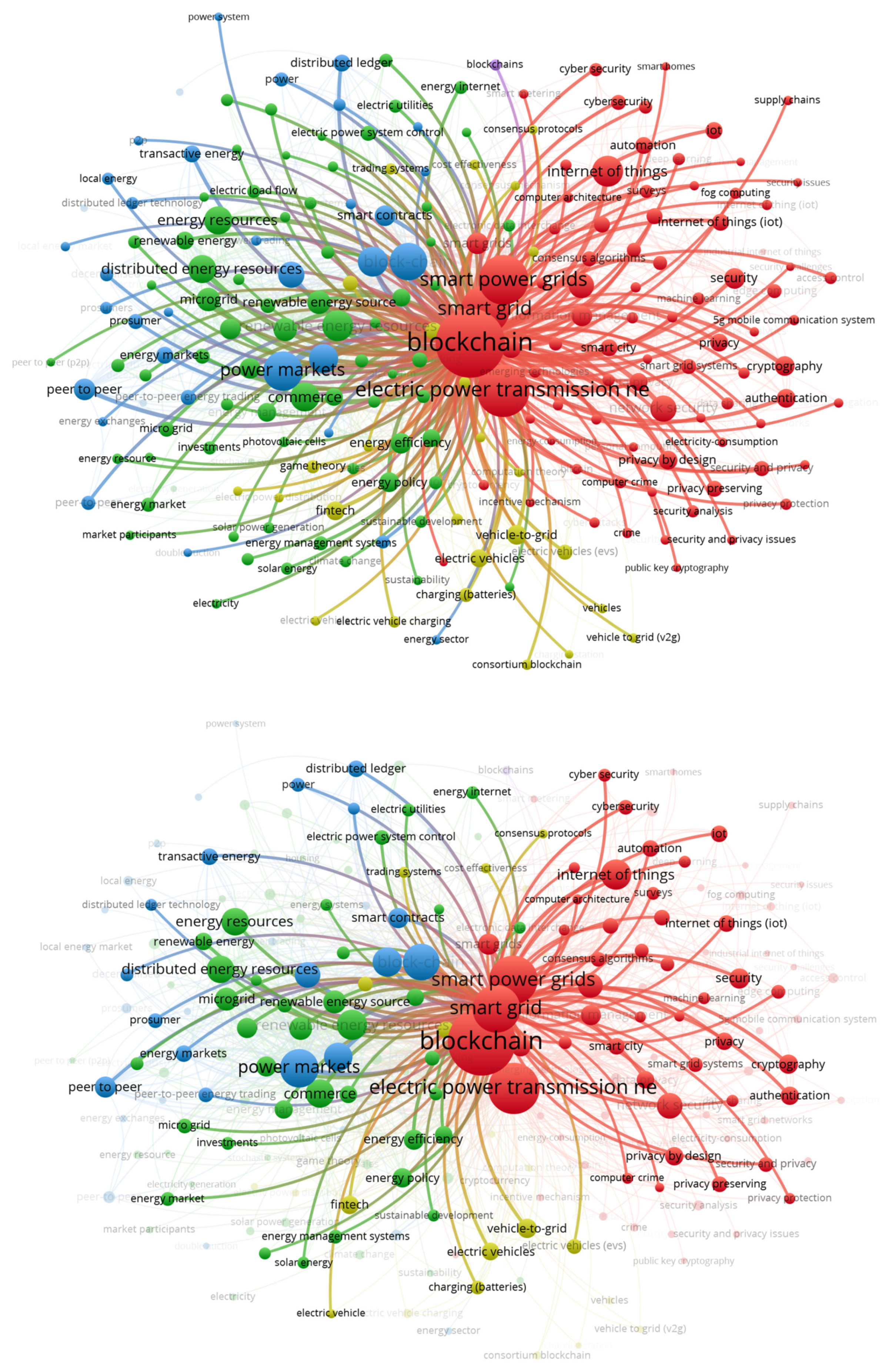
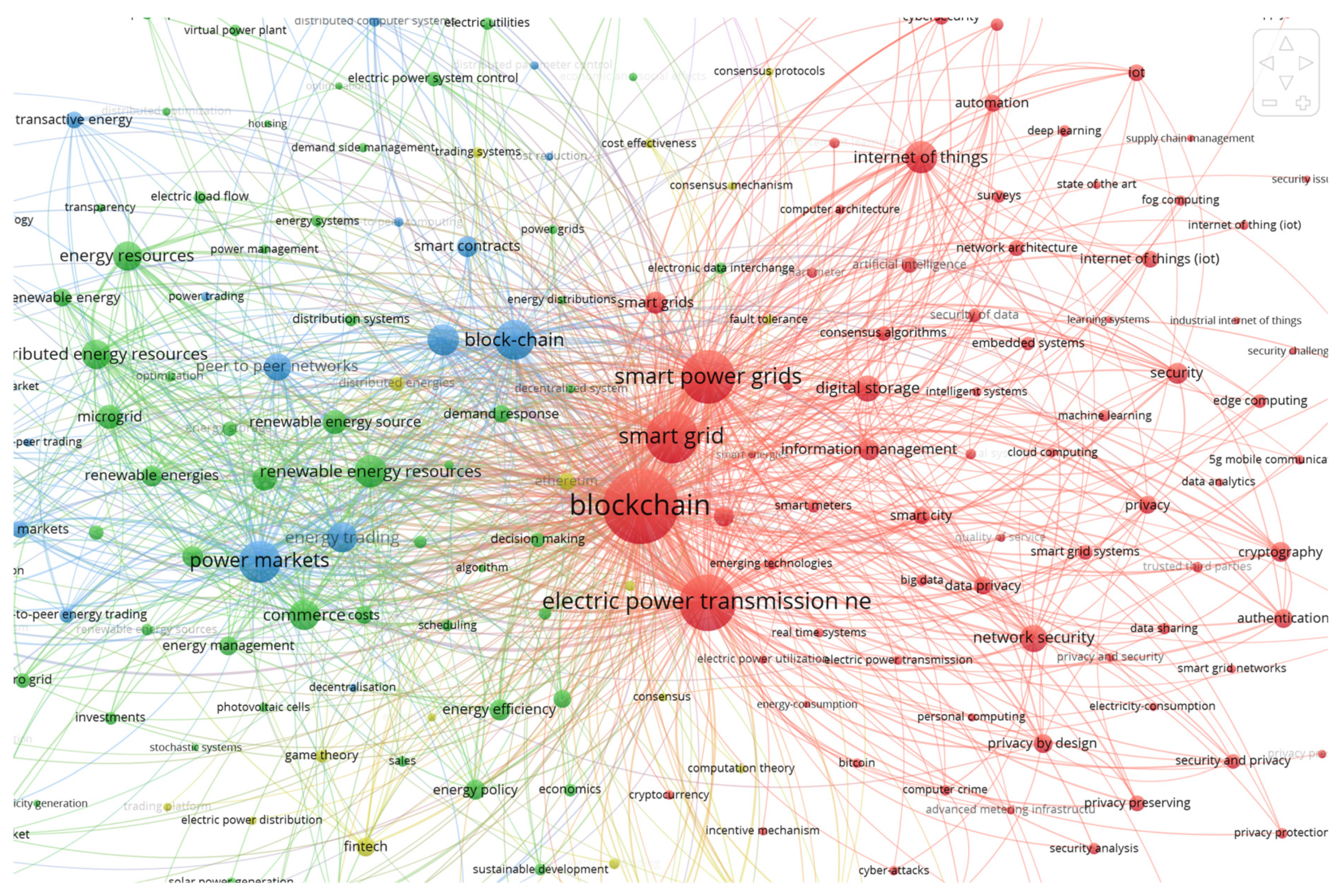
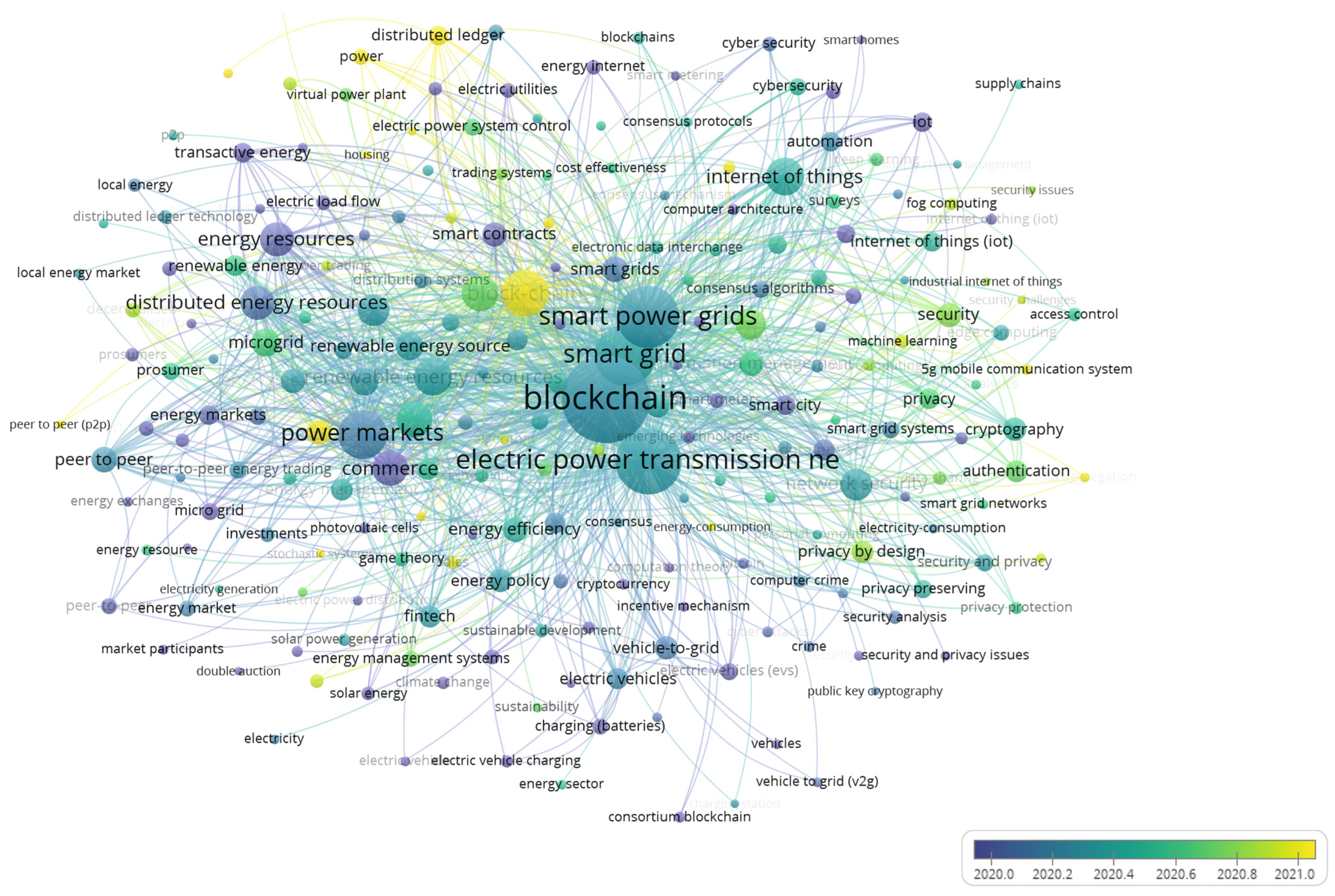
References
- Lopes, J.A.P.; Madureira, A.G.; Matos, M.; Bessa, R.J.; Monteiro, V.; Afonso, J.L.; Santos, S.F.; Catalão, J.P.S.; Antunes, C.H.; Magalhães, P. The future of power systems: Challenges, trends, and upcoming paradigms. WIREs Energy Environ. 2019, 9, e368. [Google Scholar] [CrossRef]
- Lind, L.; Cossent, R.; Chaves-Ávila, J.P.; Gómez San Román, T.G. Transmission and distribution coordination in power systems with high shares of distributed energy resources providing balancing and congestion management services. Wiley Interdiscip. Rev. Energy Environ. 2019, 8, e357. [Google Scholar] [CrossRef]
- EU. “2030 Climate & Energy Framework,” Climate Action-European Commission, 23 November 2016. Available online: https://ec.europa.eu/clima/policies/strategies/2030_en (accessed on 16 February 2020).
- Linnenberg, T.; Wior, I.; Schreiber, S.; Fay, A. A market-based multi-agent-system for decentralized power and grid control. In Proceedings of the IEEE 16th Conference on Emerging Technologies & Factory Automation (ETFA 2011), Toulouse, France, 5–9 September 2011; pp. 1–8. [Google Scholar] [CrossRef]
- Facchini, A. Distributed energy resources: Planning for the future. Nat. Energy 2017, 2, 17129. [Google Scholar] [CrossRef]
- Singh, A.; Parida, S. A review on distributed generation allocation and planning in deregulated electricity market. Renew. Sustain. Energy Rev. 2018, 82, 4132–4141. [Google Scholar] [CrossRef]
- Sabounchi, M.; Wei, J. A Decentralized P2P Electricity Market Model for Microgrids. In Proceedings of the in 2018 IEEE Power & Energy Society General Meeting (PESGM), Portland, OR, USA, 5–10 August 2018. [Google Scholar] [CrossRef]
- Mengelkamp, E.; Notheisen, B.; Beer, C.; Dauer, D.; Weinhardt, C. A blockchain-based smart grid: Towards sustainable local energy markets. Comput. Sci. Res. Dev. 2017, 33, 207–214. [Google Scholar] [CrossRef]
- Miglani, A.; Kumar, N.; Chamola, V.; Zeadally, S. Blockchain for Internet of Energy management: Review, solutions, and challenges. Comput. Commun. 2020, 151, 395–418. [Google Scholar] [CrossRef]
- Zeng, Z.; Li, Y.; Cao, Y.; Zhao, Y.; Zhong, J.; Sidorov, D.; Zeng, X. Blockchain Technology for Information Security of the Energy Internet: Fundamentals, Features, Strategy and Application. Energies 2020, 13, 881. [Google Scholar] [CrossRef]
- Dong, Z.; Luo, F.; Liang, G. Blockchain: A secure, decentralized, trusted cyber infrastructure solution for future energy systems. J. Mod. Power Syst. Clean Energy 2018, 6, 958–967. [Google Scholar] [CrossRef]
- Casino, F.; Dasaklis, T.K.; Patsakis, C. A systematic literature review of blockchain-based applications: Current status, classification and open issues. Telemat. Inform. 2019, 36, 55–81. [Google Scholar] [CrossRef]
- Erturk, E.; Lopez, D.; Yu, W.Y. Benefits and Risks of Using Blockchain in Smart Energy: A Literature Review. Contemp. Manag. Res. 2019, 15, 205–225. [Google Scholar] [CrossRef]
- Kirpes, B.; Mengelkamp, E.; Schaal, G.; Weinhardt, C. Design of a microgrid local energy market on a blockchain-based information system. Inf. Technol. 2019, 61, 87–99. [Google Scholar] [CrossRef]
- Siano, P.; De Marco, G.; Rolan, A.; Loia, V. A Survey and Evaluation of the Potentials of Distributed Ledger Technology for Peer-to-Peer Transactive Energy Exchanges in Local Energy Markets. IEEE Syst. J. 2019, 13, 3454–3466. [Google Scholar] [CrossRef]
- Liu, C.; Chai, K.K.; Zhang, X.; Lau, E.T.; Chen, Y. Adaptive Blockchain-Based Electric Vehicle Participation Scheme in Smart Grid Platform. IEEE Access 2018, 6, 25657–25665. [Google Scholar] [CrossRef]
- Di Silvestre, M.L.; Gallo, P.; Guerrero, J.M.; Musca, R.; Sanseverino, E.R.; Sciumè, G.; Vasquez, J.C.; Zizzo, G. Blockchain for power systems: Current trends and future applications. Renew. Sustain. Energy Rev. 2020, 119, 109585. [Google Scholar] [CrossRef]
- Rathor, S.K.; Saxena, D. Energy management system for smart grid: An overview and key issues. Int. J. Energy Res. 2020, 44, 4067–4109. [Google Scholar] [CrossRef]
- Khajeh, H.; Laaksonen, H.; Gazafroudi, A.S.; Shafie-Khah, M. Towards Flexibility Trading at TSO-DSO-Customer Levels: A Review. Energies 2019, 13, 165. [Google Scholar] [CrossRef]
- Chen, X.; Zhang, X. Secure Electricity Trading and Incentive Contract Model for Electric Vehicle Based on Energy Blockchain. IEEE Access 2019, 7, 178763–178778. [Google Scholar] [CrossRef]
- Liu, C.; Chai, K.K.; Zhang, X.; Chen, Y. Enhanced proof-of-benefit: A secure blockchain-enabled EV charging system. In Proceedings of the 2019 IEEE 90th Vehicular Technology Conference, Honolulu, HI, USA, 22–25 September 2019. [Google Scholar] [CrossRef]
- O’Donovan, P.; O’Sullivan, D.T.J. A Systematic Analysis of Real-World Energy Blockchain Initiatives. Futur. Internet 2019, 11, 174. [Google Scholar] [CrossRef]
- Andoni, M.; Robu, V.; Flynn, D.; Abram, S.; Geach, D.; Jenkins, D.; McCallum, P.; Peacock, A. Blockchain technology in the energy sector: A systematic review of challenges and opportunities. Renew. Sustain. Energy Rev. 2019, 100, 143–174. [Google Scholar] [CrossRef]
- Caires, L. Again, the Role of Conference Papers in Computer Science and Informatics. Commun. ACM 2015, 53, 129–132. [Google Scholar]
- Svetec, E.; Nad, L.; Pasicko, R.; Pavlin, B. Blockchain application in renewable energy microgrids: An overview of existing technology towards creating climate-resilient and energy independent communities. In Proceedings of the 2019 16th International Conference on the European Energy Market, Ljubljana, Slovenia, 18–20 September 2019. [Google Scholar] [CrossRef]
- Alladi, T.; Chamola, V.; Rodrigues, J.J.P.C.; Kozlov, S.A. Blockchain in Smart Grids: A Review on Different Use Cases. Sensors 2019, 19, 4862. [Google Scholar] [CrossRef] [PubMed]
- Mattos, D.M.F.; De Medeiros, D.S.V.; Passos, D.; Fernandes, N.C.; Saade, D.C.M.; Moraes, I.M.; De Albuquerque, C.V. Blockchain for smart grid security: Applications, trends, and challenges. Int. J. Intell. Syst. Technol. Appl. 2021, 20, 296. [Google Scholar] [CrossRef]
- Guo, Y.; Wan, Z.; Cheng, X. When blockchain meets smart grids: A comprehensive survey. High-Confidence Comput. 2022, 2, 100059. [Google Scholar] [CrossRef]
- Kushch, S.; Castrillo, F.P. A review of the applications of the Block-chain technology in smart devices and dis-tributed renewable energy grids. ADCAIJ Adv. Distrib. Comput. Artif. Intell. J. 2017, 6, 75–84. [Google Scholar] [CrossRef]
- Denyer, D.; Tranfield, D. Producing a systematic review. In The Sage Handbook of Organizational Research Methods; Sage Publications Ltd.: Thousand Oaks, CA, USA, 2009; pp. 671–689. [Google Scholar]
- Booth, A.; Sutton, A.; Papaioannou, D. Systematic Approaches to a Successful Literature Review; SAGE: Thousand Oaks, CA, USA, 2016. [Google Scholar]
- Egger, J.; Masood, T. Augmented reality in support of intelligent manufacturing – A systematic literature review. Comput. Ind. Eng. 2019, 140, 106195. [Google Scholar] [CrossRef]
- Hua, W.; Sun, H. A Blockchain-Based Peer-to-Peer Trading Scheme Coupling Energy and Carbon Markets. In Proceedings of the 2019 International Conference on Smart Energy Systems and Technologies, Porto, Portugal, 9–11 September 2019. [Google Scholar] [CrossRef]
- Niu, D.; Zhang, D. Research and implementation of power distribution systyem security protection technology based on blockchain. In Proceedings of the 3rd International Conference on High Performance Compilation, Computing and Communications, Xi’an, China, 8–10 March 2019; pp. 113–117. [Google Scholar] [CrossRef]
- Sheikh, A.; Kamuni, V.; Urooj, A.; Wagh, S.; Singh, N.; Patel, D. Secured Energy Trading Using Byzantine-Based Blockchain Consensus. IEEE Access 2020, 8, 8554–8571. [Google Scholar] [CrossRef]
- Nurgaliev, A.S.; Vershinin, I.S.; Minyazev, R.S. Concept and implementation of blockchain demonstration unit within the smart grid. In Proceedings of the 2019 International Conference on Industrial Engineering, Applications and Manufacturing, Sochi, Russia, 25–29 March 2019. [Google Scholar] [CrossRef]
- Gür, A.O.; Öksüzer, Ş.; Karaarslan, E. Blockchain Based Metering and Billing System Proposal with Privacy Protection for the Electric Network. In Proceedings of the 2019 7th International Istanbul Smart Grids and Cities Congress and Fair (ICSG), Istanbul, Turkey, 25–26 April 2019; pp. 204–208. [Google Scholar] [CrossRef]
- Wang, S.; Taha, A.F.; Wang, J.; Kvaternik, K.; Hahn, A. Energy Crowdsourcing and Peer-to-Peer Energy Trading in Blockchain-Enabled Smart Grids. IEEE Trans. Syst. Man Cybern. Syst. 2019, 49, 1612–1623. [Google Scholar] [CrossRef]
- Khorasany, M.; Dorri, A.; Razzaghi, R.; Jurdak, R. Lightweight blockchain framework for location-aware peer-to-peer energy trading. Int. J. Electr. Power Energy Syst. 2021, 127, 106610. [Google Scholar] [CrossRef]
- Foti, M.; Vavalis, M. Blockchain based uniform price double auctions for energy markets. Appl. Energy 2019, 254, 113604. [Google Scholar] [CrossRef]
- Afzal, M.; Huang, Q.; Amin, W.; Umer, K.; Raza, A.; Naeem, M. Blockchain Enabled Distributed Demand Side Management in Community Energy System with Smart Homes. IEEE Access 2020, 8, 37428–37439. [Google Scholar] [CrossRef]
- Armani, F.B.; Grimaccia, F.; Leva, S.; Mussetta, M. Seamless Grid: An off-chain model proposal for scalable P2P electricity markets and grids management. In Proceedings of the 2019 IEEE Milan PowerTech, Milan, Italy, 23–27 June 2019. [Google Scholar] [CrossRef]
- Goranovic, A.; Meisel, M.; Wilker, S.; Sauter, T. Hyperledger Fabric Smart Grid Communication Testbed on Raspberry PI ARM Architecture. In Proceedings of the 2019 15th IEEE International Workshop on Factory Communication Systems (WFCS), Sundsvall, Sweden, 27–29 May 2019. [Google Scholar] [CrossRef]
- Patsonakis, C.; Terzi, S.; Moschos, I.; Ioannidis, D.; Votis, K.; Tzovaras, D. Permissioned Blockchains and Virtual Nodes for Reinforcing Trust between Aggregators and Prosumers in Energy Demand Response Scenarios. In Proceedings of the 2019 IEEE International Conference on Environment and Electrical Engineering and 2019 IEEE Industrial and Commercial Power Systems Europe (EEEIC/I&CPS Europe), Genova, Italy, 11–14 June 2019. [Google Scholar] [CrossRef]
- Jindal, A.; Aujla, G.S.; Kumar, N. SURVIVOR: A blockchain based edge-as-a-service framework for secure energy trading in SDN-enabled vehicle-to-grid environment. Comput. Networks 2019, 153, 36–48. [Google Scholar] [CrossRef]
- Ahl, A.; Yarime, M.; Goto, M.; Chopra, S.S.; Kumar, N.M.; Tanaka, K.; Sagawa, D. Exploring blockchain for the energy transition: Opportunities and challenges based on a case study in Japan. Renew. Sustain. Energy Rev. 2019, 117, 109488. [Google Scholar] [CrossRef]
- Fan, M.; Zhang, X. Consortium Blockchain Based Data Aggregation and Regulation Mechanism for Smart Grid. IEEE Access 2019, 7, 35929–35940. [Google Scholar] [CrossRef]
- Su, Z.; Wang, Y.; Xu, Q.; Fei, M.; Tian, Y.-C.; Zhang, N. A Secure Charging Scheme for Electric Vehicles with Smart Communities in Energy Blockchain. IEEE Internet Things J. 2019, 6, 4601–4613. [Google Scholar] [CrossRef]
- Brilliantova, V.; Thurner, T.W. Blockchain and the future of energy. Technol. Soc. 2019, 57, 38–45. [Google Scholar] [CrossRef]
- Wang, N.; Xu, W.; Xu, Z.; Shao, W. Peer-to-Peer Energy Trading among Microgrids with Multidimensional Willingness. Energies 2018, 11, 3312. [Google Scholar] [CrossRef]
- Ferrag, M.A.; Maglaras, L. DeepCoin: A Novel Deep Learning and Blockchain-Based Energy Exchange Framework for Smart Grids. IEEE Trans. Eng. Manag. 2019, 67, 1285–1297. [Google Scholar] [CrossRef]
- Choudhry, A.; Dimobi, I.; Gould, Z.M.I. Blockchain Driven Platform for Energy Distribution in a Microgrid. In Data Privacy Management, Cryptocurrencies and Blockchain Technology; Springer: Berlin/Heidelberg, Germany, 2019; p. 288. [Google Scholar]
- Dorri, A.; Luo, F.; Kanhere, S.S.; Jurdak, R.; Dong, Z.Y. SPB: A Secure Private Blockchain-Based Solution for Distributed Energy Trading. IEEE Commun. Mag. 2019, 57, 120–126. [Google Scholar] [CrossRef]
- Han, W.; Xiao, Y. Privacy preservation for V2G networks in smart grid: A survey. Comput. Commun. 2016, 91–92, 17–28. [Google Scholar] [CrossRef]
- Aitzhan, N.Z.; Svetinovic, D. Security and Privacy in Decentralized Energy Trading Through Multi-Signatures, Blockchain and Anonymous Messaging Streams. IEEE Trans. Dependable Secur. Comput. 2018, 15, 840–852. [Google Scholar] [CrossRef]
- Zhang, Y.; Eisele, S.; Dubey, A.; Laszka, A.; Srivastava, A.K. Cyber-physical simulation platform for security assessment of transactive energy systems. In Proceedings of the 2019 7th Workshop on Modeling and Simulation of Cyber-Physical Energy Systems (MSCPES), Montreal, QC, Canada, 15 April 2019. [Google Scholar] [CrossRef]
- Khalid, R.; Javaid, N.; Almogren, A.; Javed, M.U.; Javaid, S.; Zuair, M. A Blockchain-Based Load Balancing in Decentralized Hybrid P2P Energy Trading Market in Smart Grid. IEEE Access 2020, 8, 47047–47062. [Google Scholar] [CrossRef]
- Li, Z.; Bahramirad, S.; Paaso, A.; Yan, M.; Shahidehpour, M. Blockchain for decentralized transactive energy management system in networked microgrids. Electr. J. 2019, 32, 58–72. [Google Scholar] [CrossRef]
- Guan, Z.; Si, G.; Zhang, X.; Wu, L.; Guizani, N.; Du, X.; Ma, Y. Privacy-Preserving and Efficient Aggregation Based on Blockchain for Power Grid Communications in Smart Communities. IEEE Commun. Mag. 2018, 56, 82–88. [Google Scholar] [CrossRef]
- Wang, J.; Wang, Q.; Zhou, N.; Chi, Y. A Novel Electricity Transaction Mode of Microgrids Based on Blockchain and Continuous Double Auction. Energies 2017, 10, 1971. [Google Scholar] [CrossRef]
- Li, Y.; Rahmani, R.; Fouassier, N.; Stenlund, P.; Ouyang, K. A Blockchain-based Architecture for Stable and Trustworthy Smart Grid. Procedia Comput. Sci. 2019, 155, 410–416. [Google Scholar] [CrossRef]
- Chen, Y. Consortium blockchains-based deep deterministic policy gradient algorithm for optimal electricity trading among households. J. China Univ. Post Telecom. 2018, 25, 7–20. [Google Scholar] [CrossRef]
- Xu, S.; Yang, N.; Zhou, Q. A Smart Grid Privacy Protection Scheme Based on Short Fail-Stop Signature; Springer: Berlin/Heidelberg, Germany, 2020; Volume 1156, p. 266. [Google Scholar]
- Van Cutsem, O.; Dac, D.H.; Boudou, P.; Kayal, M. Cooperative energy management of a community of smart-buildings: A Blockchain approach. Int. J. Electr. Power Energy Syst. 2019, 117, 105643. [Google Scholar] [CrossRef]
- Wang, H.; Wang, Q.; He, D.; Li, Q.; Liu, Z. BBARS: Blockchain-Based Anonymous Rewarding Scheme for V2G Networks. IEEE Internet Things J. 2019, 6, 3676–3687. [Google Scholar] [CrossRef]
- Huh, J.-H.; Kim, S.-K. The Blockchain Consensus Algorithm for Viable Management of New and Renewable Energies. Sustainability 2019, 11, 3184. [Google Scholar] [CrossRef]
- Zhao, Z.; Nakayama, K.; Sharma, R. Decentralized Transactive Energy Auctions with Bandit Learning. In Proceedings of the 2019 IEEE PES Transactive Energy Systems Conference (TESC 2019), Minneapolis, MN, USA, 8–11 July 2019. [Google Scholar] [CrossRef]
- Kang, J.; Yu, R.; Huang, X.; Maharjan, S.; Zhang, Y.; Hossain, E. Enabling Localized Peer-to-Peer Electricity Trading Among Plug-in Hybrid Electric Vehicles Using Consortium Blockchains. IEEE Trans. Ind. Inform. 2017, 13, 3154–3164. [Google Scholar] [CrossRef]
- Inayat, K.; Hwang, S.O. Load balancing in decentralized smart grid trade system using blockchain. J. Intell. Fuzzy Syst. 2018, 35, 5901–5911. [Google Scholar] [CrossRef]
- Zhang, T.; Pota, H.; Chu, C.-C.; Gadh, R. Real-time renewable energy incentive system for electric vehicles using prioritization and cryptocurrency. Appl. Energy 2018, 226, 582–594. [Google Scholar] [CrossRef]
- Liu, L.; Li, B.; Qi, B.; Qin, Q.; Sun, Y.; Chen, S.; Zhu, C. Reliable interoperation of demand response entities considering reputation based on blockchain. IEEJ Trans. Electr. Electron. Eng. 2019, 15, 108–120. [Google Scholar] [CrossRef]
- Zanghi, E.; Filho, M.B.D.C.; de Souza, J.C.S. Conceptual framework for blockchain-based metering systems. Multiagent Grid Syst. 2019, 15, 77–97. [Google Scholar] [CrossRef]
- Thomas, L.; Zhou, Y.; Long, C.; Wu, J.; Jenkins, N. A general form of smart contract for decentralized energy systems management. Nat. Energy 2019, 4, 140–149. [Google Scholar] [CrossRef]
- Alskaif, T.; van Leeuwen, G. Decentralized Optimal Power Flow in Distribution Networks Using Blockchain. In Proceedings of the SEST 2019-2nd International Conference on Smart Energy Systems and Technologies, Porto, Portugal, 9–11 September 2019. [Google Scholar] [CrossRef]
- Zamfirescu, A.; Suhan, C.; Golovanov, N. Blockchain Technology Application in Improving of Energy Efficiency and Power Quality. In Proceedings of the 2019 54th International Universities Power Engineering Conference (UPEC), Bucharest, Romania, 3–6 September 2019. [Google Scholar] [CrossRef]
- Mengelkamp, E.; Gärttner, J.; Rock, K.; Kessler, S.; Orsini, L.; Weinhardt, C. Designing microgrid energy markets: A case study: The Brooklyn Microgrid. Appl. Energy 2018, 210, 870–880. [Google Scholar] [CrossRef]
- Wang, J.; Wu, L.; Choo, K.-K.R.; He, D. Blockchain-Based Anonymous Authentication with Key Management for Smart Grid Edge Computing Infrastructure. IEEE Trans. Ind. Informatics 2020, 16, 1984–1992. [Google Scholar] [CrossRef]
- Ashley, M.J.; Johnson, M.S. Establishing a Secure, Transparent, and Autonomous Blockchain of Custody for Renewable Energy Credits and Carbon Credits. IEEE Eng. Manag. Rev. 2018, 46, 100–102. [Google Scholar] [CrossRef]
- Zhang, C.; Yang, T.; Wang, Y. Peer-to-Peer energy trading in a microgrid based on iterative double auction and blockchain. Sustain. Energy Grids Netw. 2021, 27, 100524. [Google Scholar] [CrossRef]
- Meeuw, A.; Schopfer, S.; Wortmann, F. Experimental bandwidth benchmarking for P2P markets in blockchain managed microgrids. Energy Procedia 2019, 159, 370–375. [Google Scholar] [CrossRef]
- Yin, S.; Wang, J.; Qiu, F. Decentralized electricity market with transactive energy – A path forward. Electr. J. 2019, 32, 7–13. [Google Scholar] [CrossRef]
- Luo, F.; Dong, Z.Y.; Liang, G.; Murata, J.; Xu, Z. A Distributed Electricity Trading System in Active Distribution Networks Based on Multi-Agent Coalition and Blockchain. IEEE Trans. Power Syst. 2019, 34, 4097–4108. [Google Scholar] [CrossRef]
- Padghan, P.R.; Daniel, S.A.; Pitchaimuthu, R. Grid-tied energy cooperative trading framework between Prosumer to Prosumer based on Ethereum smart contracts. Sustain. Energy Grids Netw. 2022, 32, 100860. [Google Scholar] [CrossRef]
- Wang, X.; Liu, P.; Ji, Z. Trading platform for cooperation and sharing based on blockchain within multi-agent energy internet. Glob. Energy Interconnect. 2021, 4, 384–393. [Google Scholar] [CrossRef]
- Gough, M.; Santos, S.F.; Almeida, A.; Lotfi, M.; Javadi, M.S.; Fitiwi, D.Z.; Osorio, G.J.; Castro, R.; Catalao, J.P.S. Blockchain-Based Transactive Energy Framework for Connected Virtual Power Plants. IEEE Trans. Ind. Appl. 2021, 58, 986–995. [Google Scholar] [CrossRef]
- Talat, R.; Muzammal, M.; Qu, Q.; Zhou, W.; Najam-Ul-Islam, M.; Bamakan, S.M.H.; Qiu, J. A Decentralized System for Green Energy Distribution in a Smart Grid. J. Energy Eng. 2020, 146. [Google Scholar] [CrossRef]
- Huang, X.; Zhang, Y.; Li, D.; Han, L. A Solution for Bilayer Energy-Trading Management in Microgrids Using Multiblockchain. IEEE Internet Things J. 2022, 9, 13886–13900. [Google Scholar] [CrossRef]
- Krause, M.J.; Tolaymat, T. Quantification of energy and carbon costs for mining cryptocurrencies. Nat. Sustain. 2018, 1, 11. [Google Scholar] [CrossRef]
- Agung, A.A.G.; Handayani, R. Blockchain for smart grid. J. King Saud Univ. Comput. Inf. Sci. 2020, 34, 3. [Google Scholar] [CrossRef]
- Pradhan, N.R.; Singh, A.P.; Kumar, N.; Hassan, M.M.; Roy, D.S. A Flexible Permission Ascription (FPA)-Based Blockchain Framework for Peer-to-Peer Energy Trading with Performance Evaluation. IEEE Trans. Ind. Inform. 2021, 18, 2465–2475. [Google Scholar] [CrossRef]
- Radi, E.M.; Lasla, N.; Bakiras, S.; Mahmoud, M. Privacy-Preserving Electric Vehicle Charging for Peer-to-Peer Energy Trading Ecosystems. In Proceedings of the ICC 2019-2019 IEEE International Conference on Communications (ICC), Shanghai, China, 20–24 May 2019. [Google Scholar] [CrossRef]
- Shibu, N.B.S.; Balamurugan, S.; Arjun, D.; Mahesh, A.N. Decentralized power system and future mobility: The use cases of community driven electric vehicle charging infrastructure. In Proceedings of the TESCA’19: Proceedings of the 1st ACM International Workshop on Technology Enablers and Innovative Applications for Smart Cities and Communities, New York, NY, USA, 13–14 November 2019; pp. 50–53. [Google Scholar] [CrossRef]
- Aggarwal, S.; Kumar, N.; Gope, P. An Efficient Blockchain-Based Authentication Scheme for Energy-Trading in V2G Networks. IEEE Trans. Ind. Inform. 2020, 17, 6971–6980. [Google Scholar] [CrossRef]
- Liu, C.; Chai, K.K.; Zhang, X.; Chen, Y. Peer-to-peer electricity trading system: Smart contracts based proof-of-benefit consensus protocol. Wirel. Networks 2019, 27, 4217–4228. [Google Scholar] [CrossRef]
- Zhou, Z.; Wang, B.; Dong, M.; Ota, K. Secure and Efficient Vehicle-to-Grid Energy Trading in Cyber Physical Systems: Integration of Blockchain and Edge Computing. IEEE Trans. Syst. Man Cybern. Syst. 2020, 50, 43–57. [Google Scholar] [CrossRef]
- Gao, J.; Asamoah, K.O.; Sifah, E.B.; Smahi, A.; Xia, Q.; Xia, H.; Zhang, X.; Dong, G. GridMonitoring: Secured Sovereign Blockchain Based Monitoring on Smart Grid. IEEE Access 2018, 6, 9917–9925. [Google Scholar] [CrossRef]
- Zhang, W.; Yang, W.; Chen, C.; Li, N.; Bao, Z.; Luo, M. Toward Privacy-Preserving Blockchain-Based Electricity Auction for V2G Networks in the Smart Grid. Secur. Commun. Netw. 2022, 2022, 1–12. [Google Scholar] [CrossRef]
- Yang, J.; Dai, J.; Gooi, H.B.; Nguyen, H.D.; Wang, P. Hierarchical Blockchain Design for Distributed Control and Energy Trading Within Microgrids. IEEE Trans. Smart Grid 2022, 13, 3133–3144. [Google Scholar] [CrossRef]
- Xu, Z.; Wang, Y.; Dong, R.; Li, W. Research on multi-microgrid power transaction process based on blockchain Technology. Electr. Power Syst. Res. 2022, 213, 108649. [Google Scholar] [CrossRef]
- Gai, K.; Wu, Y.; Zhu, L.; Qiu, M.; Shen, M. Privacy-Preserving Energy Trading Using Consortium Blockchain in Smart Grid. IEEE Trans. Ind. Informa. 2019, 15, 3548–3558. [Google Scholar] [CrossRef]
- Gai, K.; Wu, Y.; Zhu, L.; Xu, L.; Zhang, Y. Permissioned Blockchain and Edge Computing Empowered Privacy-Preserving Smart Grid Networks. IEEE Internet Things J. 2019, 6, 7992–8004. [Google Scholar] [CrossRef]
- DOE. Benefits of Demand Response in Electricity Markets and Recommendations for Achieving Them. 2006. Available online: https://www.energy.gov/sites/prod/files/oeprod/DocumentsandMedia/DOE_Benefits_of_Demand_Response_in_Electricity_Markets_and_Recommendations_for_Achieving_Them_Report_to_Congress.pdf (accessed on 13 May 2020).
- Gelazanskas, L.; Gamage, K.A. Demand side management in smart grid: A review and proposals for future direction. Sustain. Cities Soc. 2014, 11, 22–30. [Google Scholar] [CrossRef]
- Zhang, M.; Eliassen, F.; Taherkordi, A.; Jacobsen, H.-A.; Chung, H.-M.; Zhang, Y. Demand–Response Games for Peer-to-Peer Energy Trading with the Hyperledger Blockchain. IEEE Trans. Syst. Man, Cybern. Syst. 2021, 52, 19–31. [Google Scholar] [CrossRef]
- Zhang, X.; Fan, M. Blockchain-Based Secure Equipment Diagnosis Mechanism of Smart Grid. IEEE Access 2018, 6, 66165–66177. [Google Scholar] [CrossRef]
- Hao, X.; Ren, W.; Choo, K.-K.R.; Xiong, N.N. A Self-Trading and Authenticated Roaming Scheme Based on Blockchain for Smart Grids. IEEE Trans. Ind. Informatics 2022, 18, 4097–4106. [Google Scholar] [CrossRef]
- Petrovic, N.; Kocic, D. Framework for efficient energy trading in smart grids. In Proceedings of the 2019 27th Telecommunications Forum (TELFOR), Belgrade, Serbia, 26–27 November 2019. [Google Scholar] [CrossRef]
- Kavousi-Fard, A.; Almutairi, A.; Al-Sumaiti, A.; Farughian, A.; Alyami, S. An effective secured peer-to-peer energy market based on blockchain architecture for the interconnected microgrid and smart grid. Int. J. Electr. Power Energy Syst. 2021, 132, 107171. [Google Scholar] [CrossRef]
- Forsström, S.; Jennehag, U. An implemented open source blockchain market for smart grids and microgrids using autonomous agents. In Proceedings of the COINS 19: Proceedings of the International Conference on Omni-Layer Intelligent Systems, New York, NY, USA, 5–7 May 2019; Volume Part F148162, pp. 116–121. [Google Scholar] [CrossRef]
- Howson, P. Tackling climate change with blockchain. Nat. Clim. Chang. 2019, 9, 644–645. [Google Scholar] [CrossRef]
- Bansal, G.; Dua, A.; Aujla, G.S.; Singh, M.; Kumar, N. SmartChain: A smart and scalable blockchain consortium for smart grid systems. In Proceedings of the 2019 IEEE International Conference on Communications Workshops (ICC Workshops), Shanghai, China, 20–24 May 2019. [Google Scholar] [CrossRef]
- Park, S.; Kim, H. DAG-Based Distributed Ledger for Low-Latency Smart Grid Network. Energies 2019, 12, 3570. [Google Scholar] [CrossRef]
- Yang, Q.; Wang, H. Privacy-Preserving Transactive Energy Management for IoT-Aided Smart Homes via Blockchain. IEEE Internet Things J. 2021, 8, 11463–11475. [Google Scholar] [CrossRef]
- Wang, Y.; Cao, Y.; Li, Y.; Jiang, L.; Long, Y.; Deng, Y.; Zhou, Y.; Nakanishi, Y. Modelling and analysis of a two-level incentive mechanism based peer-to-peer energy sharing community. Int. J. Electr. Power Energy Syst. 2021, 133, 107202. [Google Scholar] [CrossRef]
- Sklaroff, J.M. Smart Contracts and the Cost of Inflexibility. Univ. Pa. Law Rev. 2017, 166, 43. [Google Scholar]
- Samuel, O.; Almogren, A.; Javaid, A.; Zuair, M.; Ullah, I.; Javaid, N. Leveraging Blockchain Technology for Secure Energy Trading and Least-Cost Evaluation of Decentralized Contributions to Electrification in Sub-Saharan Africa. Entropy 2020, 22, 226. [Google Scholar] [CrossRef]
- Peters, G.W.; Panayi, E. Understanding Modern Banking Ledgers Through Blockchain Technologies: Future of Transaction Processing and Smart Contracts on the Internet of Money. In Banking Beyond Banks and Money: A Guide to Banking Services in the Twenty-First Century; Tasca, P., Aste, T., Pelizzon, L., Perony, N., Eds.; Springer International Publishing: Berlin/Heidelberg, Germany, 2016; pp. 239–278. [Google Scholar]
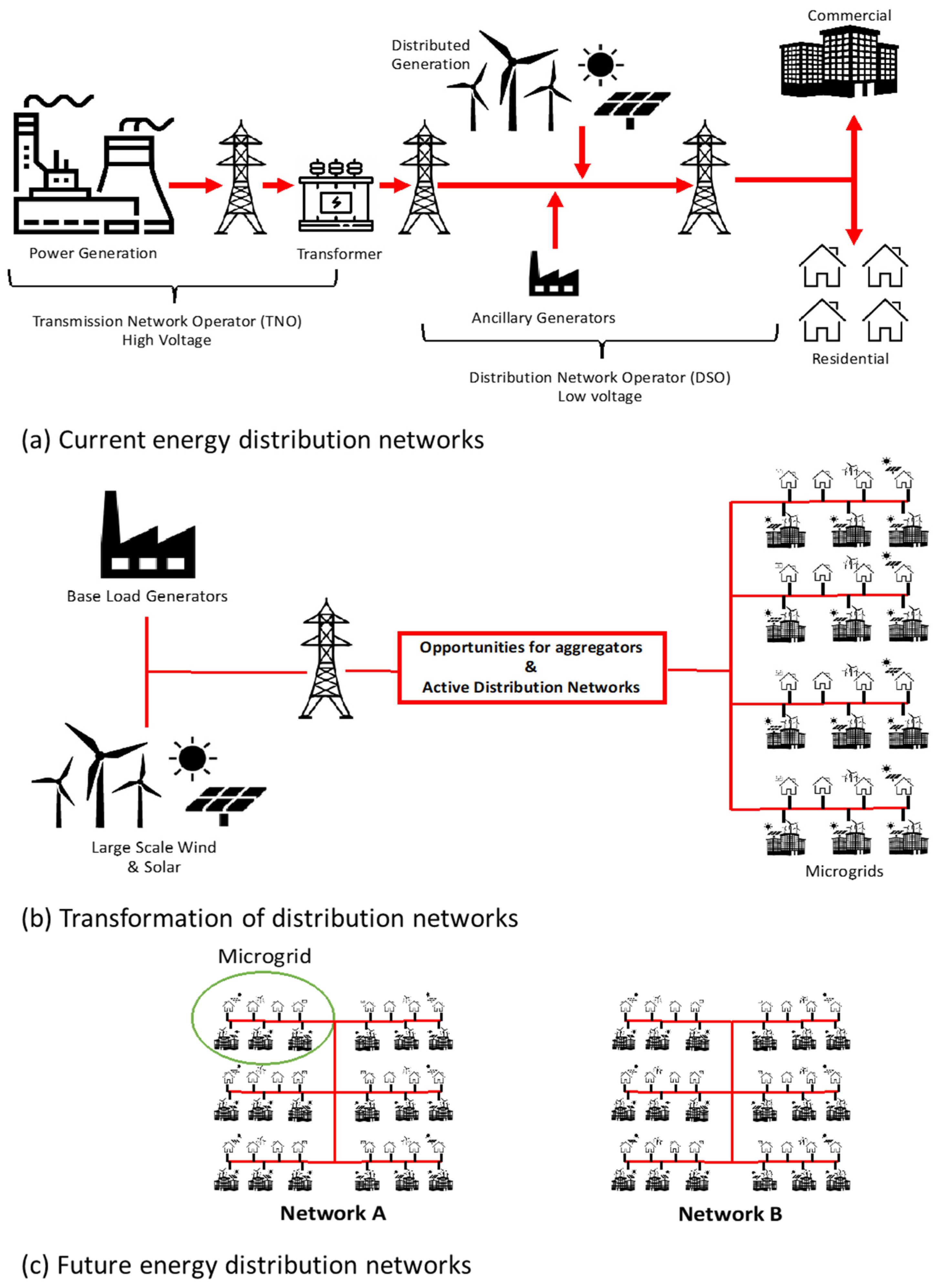
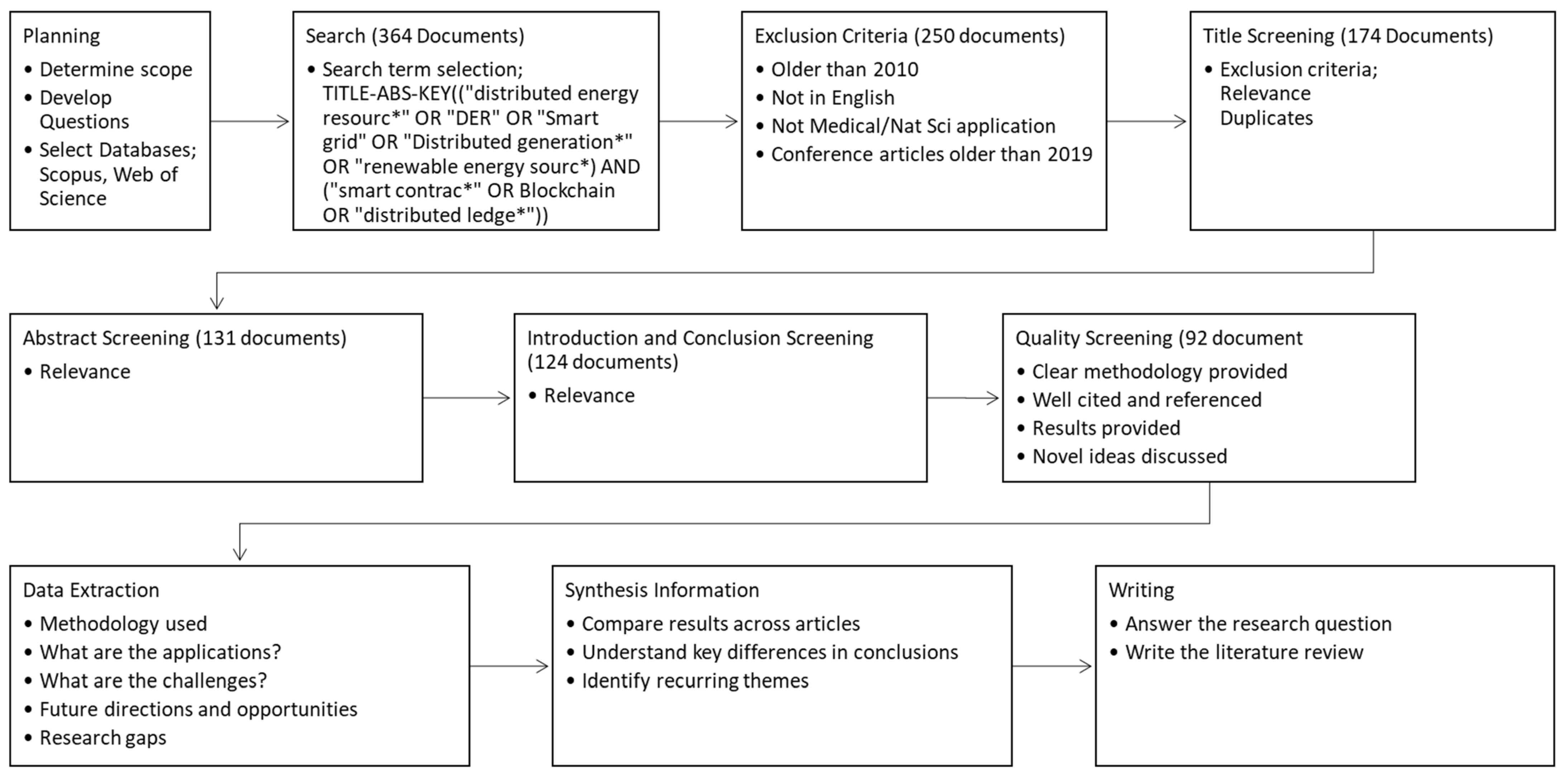
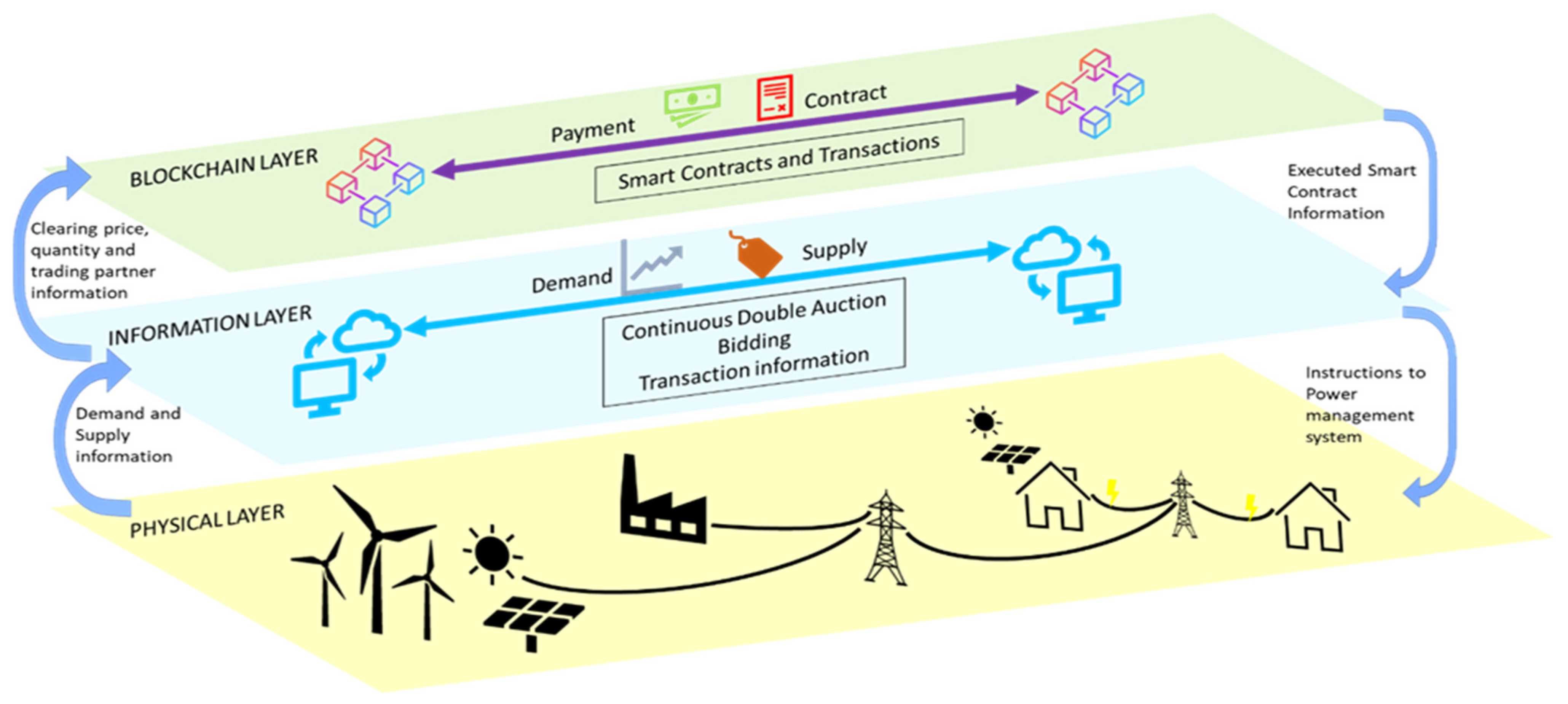
| Review Articles | Systematic Review Search Terms | Focus Area | Review Article Gaps | Future Opportunities |
|---|---|---|---|---|
| Miglani et al. (2020) [9] | Not systematic | Internet of Energy | None identified |
|
| M. L. Di Silvestre et al. (2020) [17] | Not systematic | Power Systems | None identified |
|
| z. Zeng et al. (2020) [10] | Not systematic | Information Security |
| None Presented |
| P. ’Donovan and D.T.J. O’Sullivan (2019) [22] | Systematic AND (Review OR Mapping OR Study OR Survey) AND Energy AND Blockchain | Real World Initiatives |
| None Presented |
| H. Khajeh eet al. (2019) [19] | Not systematic | Flexibility Trading |
| None Presented |
| E. Svetecet al. (2019) [25] | Not systematic | Renewable Energy Sources |
| None Presented |
| E. Erturk et al. (2019) [13] | Blockchain AND Energy | Smart Energy |
|
|
| T. Alladi et al. (2019) [26] | Not systematic | Smart Grid | None identified |
|
| M. Andoni et al. (2018) [23] | Search string not provided | Start-ups and Pilot Projects |
|
|
| S. Kushch and F. P. Castrillo (2017) [27] | Not systematic | Renewable Energy Sources |
| None Presented |
| Mattos, D.M.F. et al. (2021) [28] | Not systematic | Smart Contracts |
|
|
| Guo, Y. et al. (2022) [29] | Not systematic | Blockchain for smart grid |
|
|
| Author | Focus | Key Takeaways | Methodology | Challenges | Proposed Solution | Future Opportunities | Research Gaps |
|---|---|---|---|---|---|---|---|
| Cutsem, Ho Dac, Boudou | Demand Response | Renewable energy consumption increases through cooperation | Case Study | Create cooperation between buildings to achieve a common goal | Smart contracts | incorporating prediction uncertain for market model | What if nodes (customers) don’t respond to market or provide their schedule? |
| Smart contract Ethereum | Centralised: solutions for energy management | Day ahead planning | |||||
| Communities overall cost of energy decreases | Program Python | Issues of privacy | Real time tracking | Cost of smart contract execution | |||
| Local solution required | incentivising and penalising | ||||||
| Agung, Handyani | Blockchain network to manage transactions | Ethereum used Examples shown Mobile application developed | How to ensure generators supply after consumers pay | Smartcontracts for energy transactions | Ethereum only does 15 transactions per second | Consumers have to pay from before | |
| Who will validate the transactions? | Government plants can reduce price if needed | No promotion of clean energy | Market is regulated by the government | ||||
| Proof of work is resource intensive | No case study system not verified | ||||||
| Vavalis, Foti | Energy markets | To fulfill market step time demand the block creation time must be several magnitudes lower than the auction time (5 times) | Case Study | Decentralisation | Uniform price double auction mechanism | Effect of block generation on market competition | does not incorporate uncertainty of DERs |
| Ethereum | Enabling DERs | does not include day ahead markets | |||||
| Installing computation modules on smart computing devices can lower block size | GridLab-D for power grid simulation | Enabling smart grids | Base on blockchain for real time energy markets | Create a specialised blockchain | What about quality? | ||
| Consortium P2P network |
| Transactive Energy | EV Integration | Privacy & Security | Demand Response |
|---|---|---|---|
| Incorporation and Coordination of DERs [40] | Privacy of EV charging and user personal data [48,54] | Secure and reliable P2P Energy Trading [55,56] | Decentralisation of Demand response systems [57] |
| Match Demand and Supply [33,58] | Hackers may be able to compromise EVs through charging stations [54] | End user identification through energy consumption patterns [59] | Development of pricing mechanisms [57] |
| Reduce Cost of DER incorporation [60] | EV charging schedules to reduce grid stress [16] | Consolidation of power in private and consortium based blockchain networks [21] | Matching variable supply with uncertain demand [57] |
| Reduce energy wastage [57,61,62] | V2G capabilities to use EVs as batteries for grid stability [21] | Methods to trace transaction and identify malicious behaviour [63] | Maximise local RES consumption [64] |
| Energy Market for small scale prosumers [33] | Untracebility and Unlinkability between EV and charger [65] | Scalable consensus mechanisms [66] | Increasing consumer coordination [64] |
| Market clearing and pricing mechanisms [67] | Incentivising EVs to participate in the grid as DERs [68] | Blockchain memory issues [34] | Privacy of consumers involved in demand response schemes [69] |
| Reliable payment methods [17] | Most EVs do not possess V2G capabilities [70] | System lag due to complexity of calculations [47] | Development of trust between consumers and aggregators [71] |
Publisher’s Note: MDPI stays neutral with regard to jurisdictional claims in published maps and institutional affiliations. |
© 2022 by the authors. Licensee MDPI, Basel, Switzerland. This article is an open access article distributed under the terms and conditions of the Creative Commons Attribution (CC BY) license (https://creativecommons.org/licenses/by/4.0/).
Share and Cite
Khan, H.; Masood, T. Impact of Blockchain Technology on Smart Grids. Energies 2022, 15, 7189. https://doi.org/10.3390/en15197189
Khan H, Masood T. Impact of Blockchain Technology on Smart Grids. Energies. 2022; 15(19):7189. https://doi.org/10.3390/en15197189
Chicago/Turabian StyleKhan, Hamzah, and Tariq Masood. 2022. "Impact of Blockchain Technology on Smart Grids" Energies 15, no. 19: 7189. https://doi.org/10.3390/en15197189
APA StyleKhan, H., & Masood, T. (2022). Impact of Blockchain Technology on Smart Grids. Energies, 15(19), 7189. https://doi.org/10.3390/en15197189






